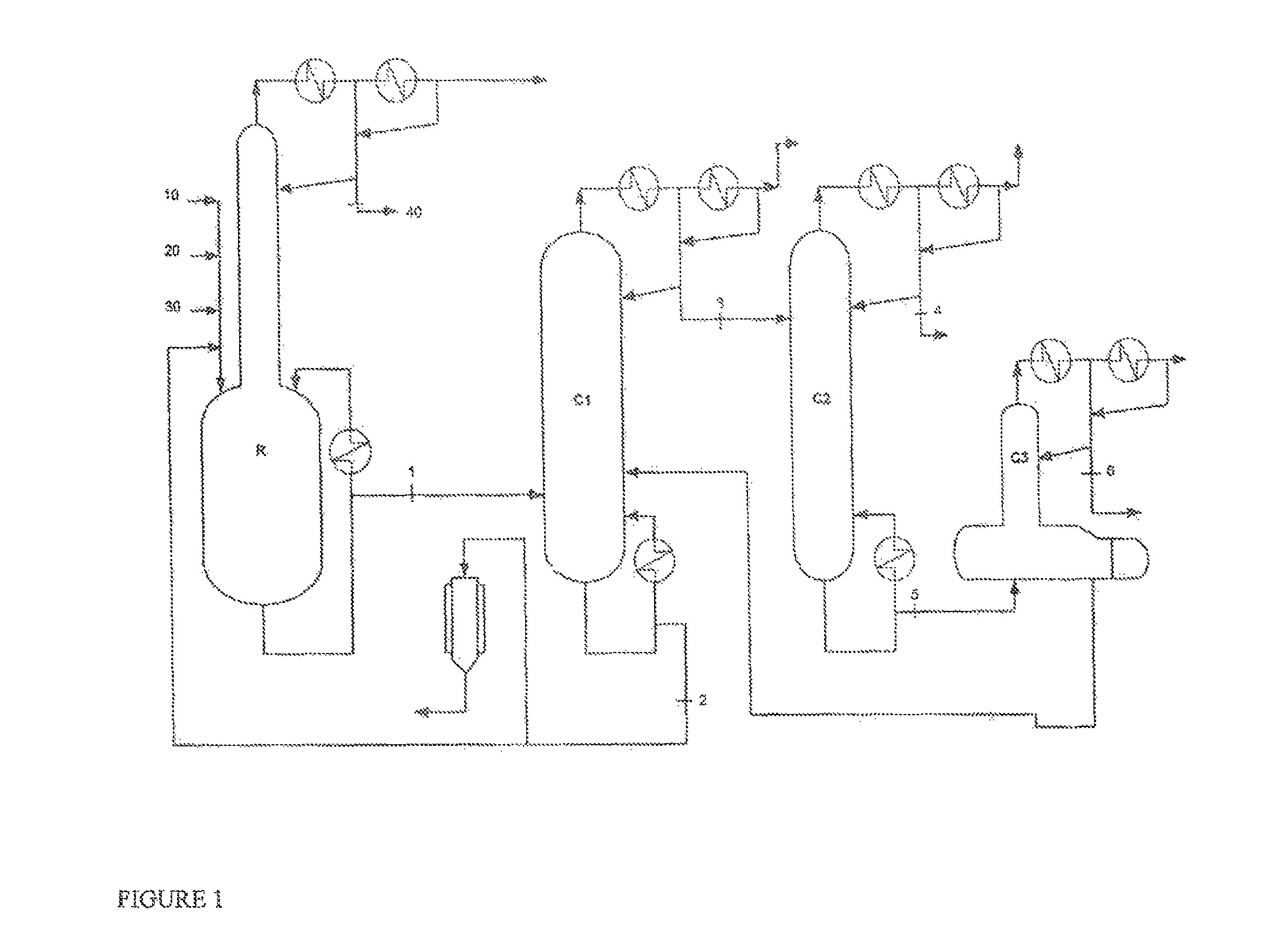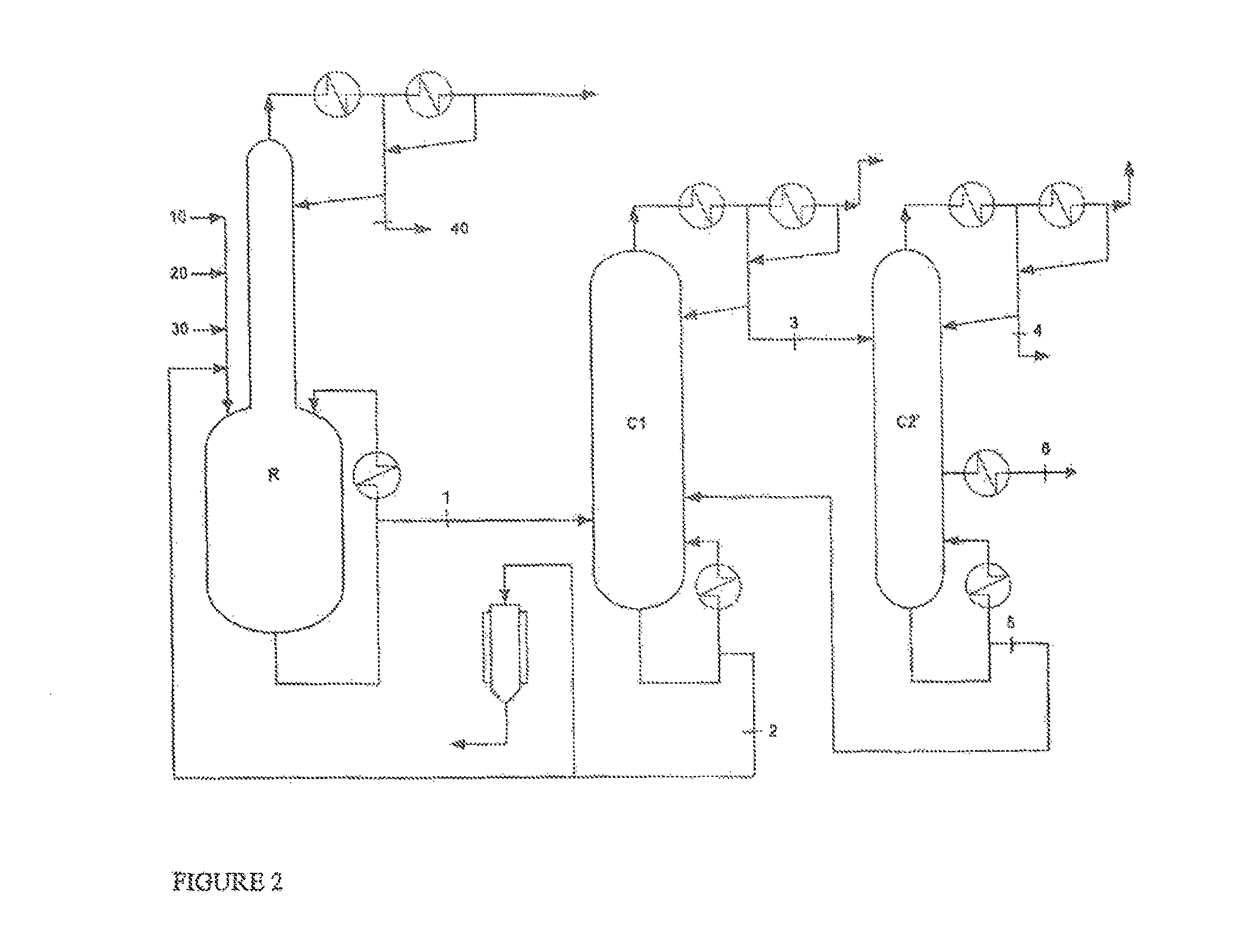Method for the production of 2-octyl acrylate by means of transesterification
a technology of acrylate and acrylate, which is applied in the preparation of ester-hydroxy reactions, chemical apparatus and processes, and organic chemistry, etc., can solve the problems of complex process, high energy consumption, and relatively simple process simultaneously
- Summary
- Abstract
- Description
- Claims
- Application Information
AI Technical Summary
Benefits of technology
Problems solved by technology
Method used
Image
Examples
example 1
According to the Invention
[0079]Ethyl acrylate, 2-octanol and a mixture of ethyl titanate in solution in 2-octanol (90% mixture of ethyl titanate in 2-octanol) with phenothiazine inhibitor, in the proportions by weight 53.8 / 45.6 / 0.6, are charged to a perfectly stirred reactor R heated by an external exchanger and surmounted by a distillation column having 12 theoretical plates.
[0080]The reactor is heated, while bubbling with air, and, as soon as the temperature reaches 115° C. under 500 mmHg (0.67×105 Pa), EA stabilized with 2000 ppm of PTZ (10), 2-octanol (20) and ethyl titanate in solution in 2-octanol (30), in proportions by weight 53.8 / 45.6 / 0.6, are continuously introduced.
[0081]At the column top, the EA / ethanol azeotrope (40), with a composition by weight of 35 / 65, is continuously withdrawn.
[0082]The crude reaction product (1), obtained by continuous reaction, comprises 2OCTA, unreacted EA, unreacted 2-octanol and a mixture comprising the catalyst with the polymerization inhibi...
example 2
Comparative
[0098]The same synthesis as in example 1 was carried out but using, as catalyst, butyl titanate as replacement for ethyl titanate.
[0099]In this case, the stream (4) distilled at the top of the column C2 comprises, in addition to the unreacted reactants with a minor fraction of 2OCTA, 15% of butyl acrylate originating from the reaction of the catalyst with the EA.
[0100]This stream (4), intended to be recycled to the reaction stage, required a preliminary purification by distillation on an additional column to remove the butyl acrylate, in order to limit the accumulation over time of butyl acrylate in the plant and the risk of contamination of the purified 2OCTA.
example 3
Comparative
[0101]The same synthesis as in example 1 was carried out but using, as catalyst, 2-ethylhexyl titanate as replacement for ethyl titanate.
[0102]In this case, 2OCTA with a purity of 97.5% was obtained at the top of the column C3 due to the presence of 2% of 2-ethylhexyl acrylate originating from the catalyst in the purified product.
[0103]The 2-octyl acrylate thus obtained does not offer the same performance in pressure-sensitive adhesives as a 2OCTA having a purity of 99.8%.
PUM
| Property | Measurement | Unit |
|---|---|---|
| molar ratio | aaaaa | aaaaa |
| temperature | aaaaa | aaaaa |
| atmospheric pressure | aaaaa | aaaaa |
Abstract
Description
Claims
Application Information
 Login to View More
Login to View More - R&D
- Intellectual Property
- Life Sciences
- Materials
- Tech Scout
- Unparalleled Data Quality
- Higher Quality Content
- 60% Fewer Hallucinations
Browse by: Latest US Patents, China's latest patents, Technical Efficacy Thesaurus, Application Domain, Technology Topic, Popular Technical Reports.
© 2025 PatSnap. All rights reserved.Legal|Privacy policy|Modern Slavery Act Transparency Statement|Sitemap|About US| Contact US: help@patsnap.com



